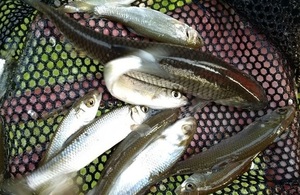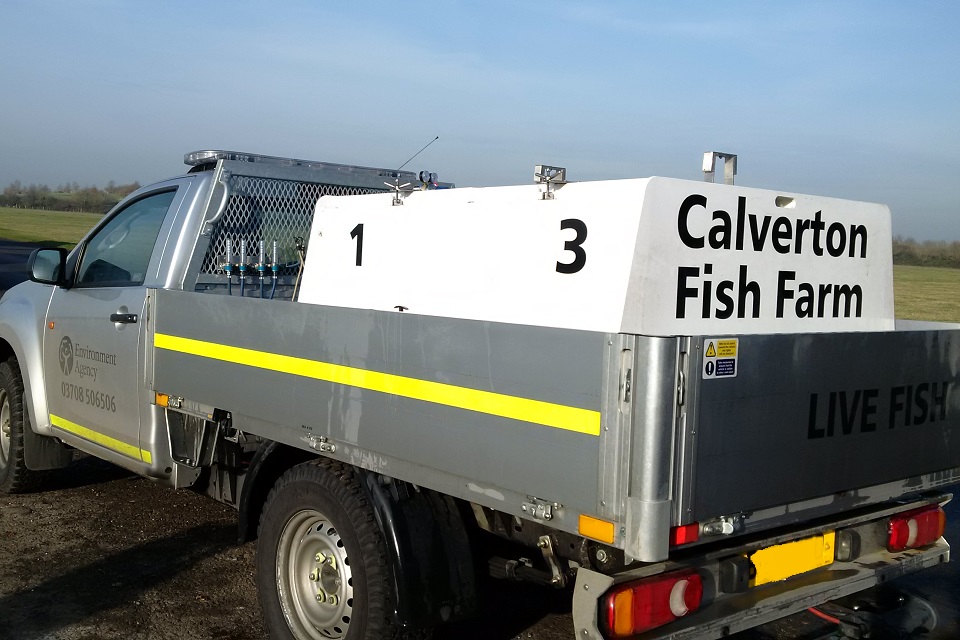Environment Agency’s Christmas stocking for Berkshire anglers
Thousands of fish are being re-homed into the River Cut in Bracknell.

Fish being stocked into a river in Bracknell.
The Environment Agency is delivering an early Christmas gift to anglers in Berkshire this week, when it carries out a Christmas stocking of young adult fish into the River Cut at Jocks Lane recreation ground in Bracknell.
Thousands of fish, including roach, dace and chub, will be added to the river’s existing fish population this Thursday, 14 December. This will provide an immediate boost to numbers, which will be multiplied many times over when the new arrivals settle into their new homes and begin to produce offspring.
Stuart Keable, a fisheries officer for the Environment Agency, said:
We carry out a number of fish stockings every year. Sometimes it is to help fish populations recover when they’ve suffered from a pollution incident, or through flooding, which can push large numbers of fish downstream, and many never return.
The River Cut has suffered from recurrent pollution near Jocks Lane recreation ground in 2017, where uncontaminated water from a large proportion of Bracknell drains into the Cut. Environment Agency officers have been working closely with Thames Water, which manages the surface water network, to investigate the source of the pollution. The partnership has also resulted in pollution-prevention visits to nearby industrial estates, where officers advised businesses on oil and chemical storage compliance, hazardous waste disposal and the risk to streams and rivers.
Rachel Brown, an Environment Agency team leader in east Berkshire, said:
The Environment Agency has responded to a number of incidents on the River Cut this year, reported to us through our incident hotline. We have been working with Thames Water to find why the river was polluted, whilst also reducing the impact to the environment. We have carried out pollution-prevention visits at the nearby industrial estates, to raise awareness of the surface water drainage network and correct disposal of waste. Information provided by the public is vital in helping us with these ongoing investigations, and we urge anyone witnessing an environmental pollution to call our 24-hour incident hotline on 0800 80 70 60.
Christmas is a good time to introduce the fish into rivers, as it enables them to acclimatise to their new surroundings, ahead of their spawning season in the spring. Fish also play a critical role in sustaining a river’s finely-balanced eco-system, so the wider natural environment will also get a festive boost.

Environment Agency vehicle with oxygenated tanks for transporting live fish.
Stuart Keable added:
The River Cut has undergone some fantastic enhancements recently. We’ve done a lot of that ourselves, but we increasingly work with local angling clubs, Bracknell Town Council, community groups and volunteers to get bigger and better results. The council has already installed 10 fishing platforms on the upstream section of the river at Jocks Lane, which will eventually see a wheelchair ramp installed for disabled access to this area. These improvements were made through the Angling Trust’s Angling Improvement Fund.
Through the Environment Agency’s Fisheries Improvement Programme, we have started on some major habitat improvement work in the river itself. In November, we installed the first of 10 marginal berms to provide a more diverse habitat for fish, insects, birds and plants, as well as push silt out of the system. This work will be ongoing throughout the winter. The collective contribution from our various partners to the wellbeing of the river has been immense.
The fish are being brought to site in oxygenated tanks from their birthplace and home for the last 12-18 months, the Environment Agency’s own Calverton Fish Farm in Nottingham. Funded through rod licence fees, Calverton produces some 450,000 coarse fish each year which are used to help the vitality and diversity of fish populations in rivers, lakes and ponds throughout England.
Updates to this page
Published 11 December 2017Last updated 13 December 2017 + show all updates
-
Photos updated.
-
First published.